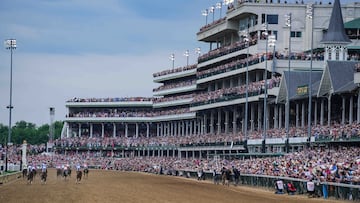What will happen to the Kentucky Derby now that Churchill Downs suspended all racing operations?
Following a series of strange events at the famed track, the prestigious Kentucky Derby will be relocated to another track. Sad news for horse racing fans.

With the very welfare of the horses now in doubt, was there really any other choice than to postpone the prestigious race? As authorities now try to get to the bottom of what has become an increasingly concerning situation, we can only sit and wait.
Churchill Downs suspend races as Kentucky Derby moved to Ellis Park
According to an announcement from Churchill Downs on Friday, all racing operations have now been suspended after an “unusual” number of horse injuries along with 12 deaths occurred at the Louisville, Kentucky track since March 30th. It is understood that the suspension will run from June 7th to July 3rd. What that means is that the rest of the Spring Meet - including the Kentucky Derby - will now be held at Ellis Park in Henderson, Kentucky. Interestingly, Ellis Park is also owned and operated by Churchill Downs Incorporated.
“In addition to our commitment to providing the safest racing environment for our participants, we have an immense responsibility as the economic engine of the Thoroughbred industry in Kentucky which provides jobs and income for thousands of families every day,” Bill Carstanjen, CEO of Churchill Downs Incorporated stated. “By relocating the remainder of the meet to Ellis Park, we are able to maintain this industry ecosystem with only minor disruption. We are grateful to the Kentucky horsemen for their support, resiliency and continued partnership as we collectively work to find answers during this time.”
What’s been happening at Churchill Downs?
To be clear, things have been quite tragic in Kentucky with the aforementioned 12 horses having to be euthanized after suffering injuries on the track. To make matters worse, the track also stated that after a series of concurrent investigations by Churchill Downs, the Kentucky Horse Racing Commission and the Horseracing Integrity and Safety Authority, “no single factor has been identified as a potential cause and no discernable pattern has been detected to link the fatalities.” Further to that, the racetrack’s surface was also found to be “consistent with prior measurements” from previous years and as such “has not raised concerns.” Be that as it may, it’s now clear that Churchill Downs is not willing to take any further risks with equine lives.
“The team at Churchill Downs takes great pride in our commitment to safety and strives to set the highest standard in racing, consistently going above and beyond the regulations and policies that are required,” Churchill Downs Incorporated CEO Bill Carstanjen said in a statement. “What has happened at our track is deeply upsetting and absolutely unacceptable. Despite our best efforts to identify a cause for the recent horse injuries, and though no issues have been linked to our racing surfaces or environment at Churchill Downs, we need to take more time to conduct a top-to-bottom review of all of the details and circumstances so that we can further strengthen our surface, safety and integrity protocols.”
Churchill Downs has already made changes
It’s worth mentioning, that prior to its announcement, Churchill Downs had already partnered with HISA to introduce a series of new safety measures including the Horseracing Integrity and Welfare Unit collecting blood and hair samples for all fatalities involving covered horses and also the restriction of horses to four starts over a rolling eight-week period. Additionally, Churchill Downs also added “ineligibility standards for poor performance,” meaning that any horse that loses a race by more than 12 lengths in five consecutive starts, won’t be allowed to feature until it is approved by an equine medical director.






